WHYMPER, Josiah Wood
As Josiah Wood Whimper, he was born at Stoke Green, Ipswich on 24 April 1813, second son of Nathaniel Whimper (1787-18 August 1861), a brewer and town councillor at Ipswich, and his first wife Elizabeth née Orris (c1791-September 1829), who married at Ipswich on 18 September 1810. The Whimper family were a well-established Suffolk family but sometime after 1840, Josiah adopted what he considered the original spelling of his name, Whymper, but his early works are signed ‘Whimper Sc’, or J. W. Whimper; later works are signed J. W. Whymper. Josiah was educated at private schools in Ipswich and then, wishing to become a sculptor, was apprenticed to a stonemason but a near-fatal accident in the mason's yard terminated his apprenticeship before he was sixteen. On his mother's death in 1829, Josiah went to London hoping to join a sculptor's studio but was dissuaded from this profession by sculptor John Charles Felix Rossi (1762-1839). He then taught himself to draw and, from 1829 studied watercolour painting with William Collingwood Smith (1815-1887). He and his brother, Ebenezar Whymper, set up a wood-engraving business at 31 Paradise Road, Lambeth, and their work on orders for shop notices led to commissions from publisher Charles Knight for 'Arabian Nights Entertainments' (1839), 'Pictorial Shakespeare', and 'Penny Magazine'. Josiah Whymper established himself as an illustrator with an etching of 'New London Bridge' on its opening in 1831, on which he made £30 profit. Finding that his brother Ebenezar was irresponsible in the running the business, about 1842 Josiah moved his business to 20 Canterbury Place, Lambeth. On 1 August 1837 he married Elizabeth Whitworth Claridge (1819–8 December 1859) of Peckham, and they had nine sons and two daughters. He intended that all his sons continue in the business but those that were successful were Alfred, who was sent to train with the Edinburgh printer R. Clark in 1857, with Frederick, Charles and young Edward Whymper being trained by Josiah as draughtsmen on wood with young Edward eventually taking over the business. Josiah was also master to an impressive succession of apprentices including Frederick Walker (1840-1875), Charles Keene, John William North (1842-1921), Charles Green (1840-1896), and George James Pinwell (1842-1875). His wood-engraving business became one of the most thriving in London, taking on most of the work for publishers John Murray, The Religious Tract Society, and the Society for Promoting Christian Knowledge. Fine examples of his book illustrations are those in Scott's 'Poetical Works', 'Picturesque Europe' and some of Murray's editions of Byron's 'Childe Harold and Schliemann's Works'; 190 engravings after Joseph Wolf for C. A. John's 'British Birds in their Haunts' (1862); and twenty engravings after Wolf for 'Life and Habits of Wild Animals'. Whymper also engraved for periodicals such as 'Illustrated London News' (1855) and 'Sunday at Home' (1869). He engraved many illustrations by Sir John Gilbert (1817-1897), his friend and constant travelling companion for watercolour sketching: 'Lady of the Lake' (1853) and 'Lay of the Last Minstrel' (1854) are two of the finest examples. Whymper was also a competent draughtsman illustrator, often engraving his own natural history illustrations which appeared in C. R. Conder's 'Child's History of Jerusalem' (1874), L. J. Jenning's 'Field Paths and Green Lanes' (1877), and C. R. Conder's 'Tent Work in Palestine' (1878). His wife, Elizabeth, died at Haslemere, Surrey in 1859, and he married secondly at St Mary's Church, Battersea on 4 December 1866, Emily Hepburn (19 December 1832-27 September 1886), second daughter of Thomas Hepburn of Clapham Common, Emily was also a talented watercolour painter, who exhibited watercolour landscapes at the Royal Academy from Haslemere in 1877 'Carnations' and 'Pansies' and in 1878 'Hollyhocks' and at the Royal Institution 1883–1885. By 1882 Whymper's engraving business at 43-45 Lambeth Road was jointly managed with his son Edward and appeared in the directories as J. W. and Edward Whymper, draughtsmen and engravers on wood. From 1859 he had a country house at Haslemere, Surrey, but did not finally retire from his work in London until 1884, when Edward took over the firm, but Edward (27 April 1840–16 September 1911) is better known for his mountaineering exploits. During Josiah's career the Whymper name had established an excellent reputation for high-quality wood-engraving. Josiah Wood Whymper died at his home, Town House, Haslemere on 7 April 1903, and buried in Haslemere churchyard. A watercolour landscape painter and although his engraving work did not allow him much time to pursue painting, he exhibited at the Royal Academy also showing frequently at the Institute of Painters in Water Colours from 1844, where he was elected associate in 1854 and member in 1857 also exhibiting at the Society of British Artists; Agnew & Sons Gallery, Walker Art Gallery; Manchester City Art Gallery, the Royal Institute of Painters in Water Colours, the Royal Institute of Oil Painters and at his birth home at the Ipswich Fine Art Club exhibiting from Haslemere in 1883, two watercolours 'Stretched Wide and Wild' and 'The Sands at Penmaenwawr, N. Wales'. His son Frederick Whymper (1838-1901) exhibited three landscapes at the Royal Academy, and three water colours at the Society of British Artists. (Copsey-Ipswich Book Trades. 2011)
Royal Academy Exhibits
from 4 Lambeth Terrace, London
1853 860 Berkeley Castle - drawing
1854 671 Dartford Common - drawing
Works by This Artist
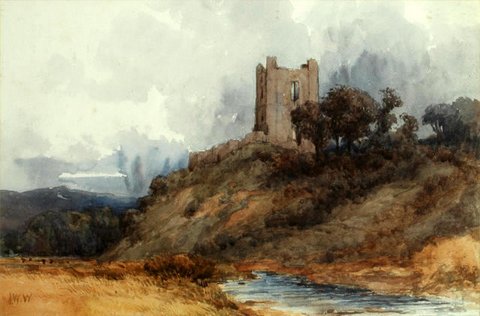
|
King James' Hunting TowerWatercolour
|
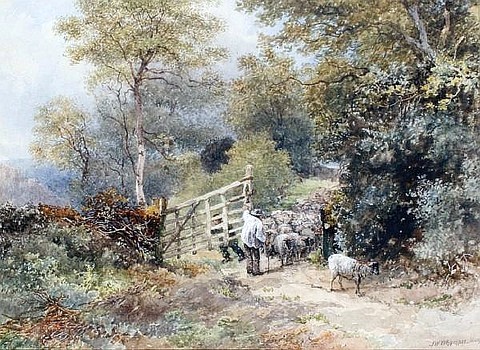
|
Moving PasturesWatercolour
|
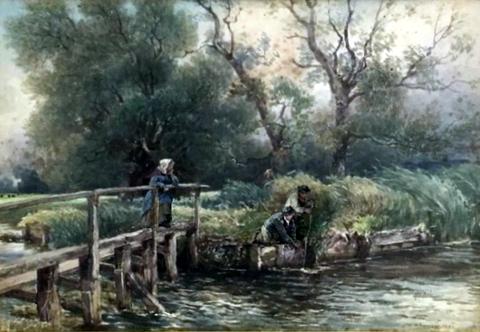
|
A Bit on the RiverWatercolour
|
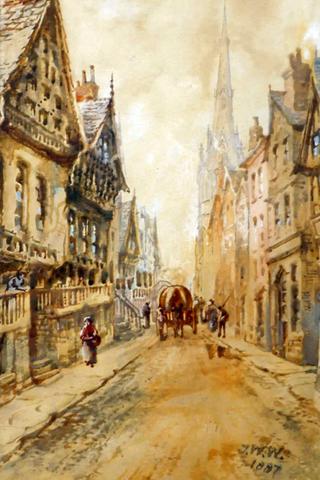
|
Street SceneWatercolour
|
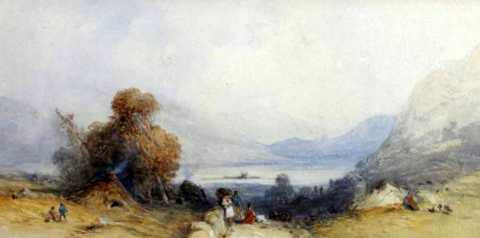
|
Woodmen RestingWatercolour
|